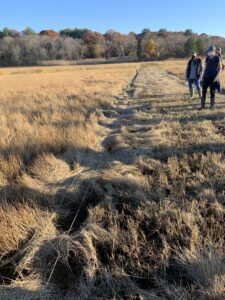
Ditch remediation. USFWS/Aimee Weldon
A newly approved NAWCA grant will enable The Trustees of Reservations and several partners to restore 916 acres of the Great Marsh, spanning several ownerships, using a combination of innovative, low-impact restoration strategies identified in the ACJV’s Saltmarsh Sparrow Conservation Plan. Restoration strategies include ditch remediation, runneling (digging shallow channels connected to existing tidal creeks), and creating microtopography (higher areas less likely to be flooded) for nesting Saltmarsh Sparrows. This work will improve the health and resiliency of areas that were once high marsh but have been rapidly degrading due to excessive “ponding” caused by a combination of sea-level rise (SLR) and historic modifications to the marsh (i.e., berms, roads, and ditches). At 16,000 acres, the Great Marsh is the largest tidal marsh complex north of New Jersey, and contains some of the most productive Saltmarsh Sparrow breeding habitat in its entire range. The areas being restored are ranked in the top 10% of all habitat patches in the entire breeding range according to the ACJV’s Saltmarsh Sparrow Habitat Prioritization Tool, and the top 1% in Massachusetts.
The ditch remediation planned is the first large-scale implementation of a technique originally developed and pilot-tested in the Great Marsh, where small patches of salt marsh hay is cut and raked into adjacent ditches, and held by twine. Filling the ditch with cut hay traps sediment in the water column, which slowly fills and heals the ditch over time. After two to three years of treatment, ditches are shallow enough to support the growth of cordgrass (Spartina alterniflora), which continues to trap sediment and produce biomass. The goal of these restoration efforts is to reverse the subsidence (i.e., sinking) of the marsh platform and increase accretion, the process of maintaining the elevation of the marsh platform relative to sea level rise. As a result of increasing the marsh resiliency, flooding of Saltmarsh Sparrow nests should be reduced. Based on SHARP survey data from the Great Marsh (Shriver 2020, Pau 2020), this project will benefit up to 480 nesting sparrows.

